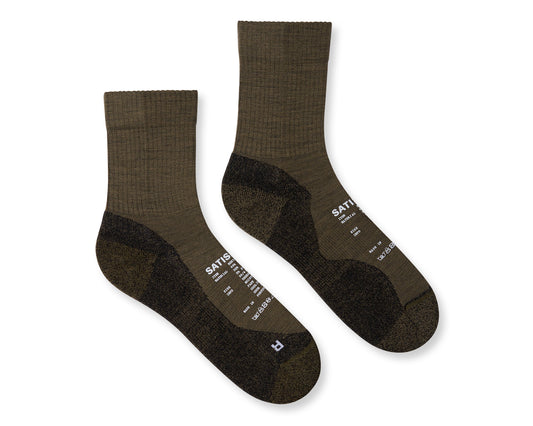

THE DOUBLE RUNNER’S HIGH

Thai Richard

Thai Richards
The Double Runner’s High by Samutaro for Possessed
The notion of the runner’s high has long been lorded in running but a growing number of athletes are combining cannabis to elevate their running regiments.
Marijuana culture has been completely revolutionized over the past decade. As places like Canada, California, Colorado and New York transition from medical marijuana to legalizing it for recreational use, weed’s social stigma is beginning to shift. The quintessential “stoner” stereotype is becoming a relic of the past, and a new wave of athletic pot smokers is emerging. It’s less the image of a lazy, overweight stoner who sprawls on the sofa for hours surrounded by a haze of smoke and half-eaten snacks, and more like an Equinox gym member who drinks cold-pressed juices and has a really nice looking vape pen.
“What cannabis does is it just elevates characteristics or personality traits you alreadyhave.”
Avery Collins, professional mountain trail runner
As marijuana becomes more accessible and popular, an increasing number of athletes are opening the discussion of cannabis use and the wellness benefits it has on their training. Although there is no evidence that it’s a performance enhancing drug, THC—the primary psychoactive ingredient in marijuana—and its connection to exercise has become a hot topic for research with many looking to uncover the science behind it. Some of the common questions raised: Can a running routine coexist with a weed habit? Is it counterintuitive to mix the two? Or alternatively, what possible benefits can weed bring to a training plan? And, if marijuana can indeed help runners, how can those potential benefits be obtained safely?
In 2019, writer Tien Nguyen of Nature spoke to social psychologist Angela Bryanwho surveyed more than 600 cannabis users living in US states where the drug is legal about their exercise habits, among other health factors. Her research revealed that four out of five respondents said that they use marijuana right before or after exercising. And those users spent more minutes per week exercising than users who didn’t mix the two. “We were shocked,” said Bryan. Her findings also uncovered that about 70% of respondents who used cannabis before working out said doing so made exercising more enjoyable.

Bryan believes that one of the reasons why runners are achieving these states of bliss during training sessions is linked to the “runner’s high”, the feeling of euphoria that kicks in when some people reach a sweet spot in their workout. Her research suggests that cannabis could in fact target the same endocannabinoid receptors that are stimulated when we reach the runners high. But while our bodies only naturally release those elusive weed-like compounds on long, random runs, she believes runners can use weed to “jumpstart” and access those pleasurable feelings early.
Although her research pointed towards the positive effects of cannabis and exercise, she stresses that the science is still yet to be found. But nevertheless, she says people say they enjoy exercise with cannabis, which could create a positive feedback loop that motivates them to go back to the gym. “If something feels good,” she says, “you’re going to want to do it again.”
It’s this impact on motivation (or lack of) and how cannabis consumption won’t necessarily undermine a runner’s enthusiasm to stick to a training schedule that is helping challenge the common misconceptions around marijuana in popular media. In fact, ultrarunners Avery Collins and Jenn Shelton aren’t shy to admit they use cannabis while training, as well as triathlete Clifford Drusinsky. They say marijuana has helped ease pain and nausea during training.
It’s this focus on combining cannabis during a light jog or strength session that Dr. Jordan Tishler, M.D., an expert in the field of medical cannabis therapeutics, believes where the best potential for the drug lies. “In situations where one is looking for peak performance, greatest strength, greatest speed, cannabis can be counter-productive,” he told Runners Podium. “But in the training or exercise approach, where peak performance is not necessarily the goal, but endurance or enjoyment is more the focus, then using small amounts of cannabis during exercise can influence people’s pain threshold and ability to tolerate prolonged exercise and generally increase people’s enjoyment of that experience.”
When we reached out to professional Mountain Trail Runner Avery Collins, he echoed the same sentiments: “There’s a mental edge that comes with pushing and I think cannabis takes away from my ability to perform mentally which ultimately also rolls into the physical aspect. If I’m not there mentally pushing then I’m not gonna be physically either. I just find that I’m typically faster without it. So I’d say about 4-5 days a week I’m using and the other 2-3 days I don’t.”
Collins first began introducing cannabis into his running routine as a way to take the monotony out of running. “When you’re living somewhere in the Midwest, or somewhere that’s a little more boring without trail access or mountains, topography and terrain changes—things to keep your mind active—those are places where I think cannabis is actually the most rewarding because it helps take you out of that head space.”
The 28-year-old now lives in Silverton, Colorado, a state region known just as much for its trails as its cannabis. His sweet spot for getting high for runs on the San Juan trails is 80% edibles and 20% smoking. “They both have different highs,” he explains. “With the edibles, there’s more of a delayed onset where you’re waiting for it to kick in for 40-45 minutes and with smoking it’s instant.” As a seasoned smoker Collins reveals that he often combines the two bwfore heading out for a 6-8 hour day. “It’s not uncommon I’ll take an edible and then also take a hit of a bowl and right before taking off for the run and by the third or fourth mile the edible is starting to kick in.”
It’s not just the feeling of enhanced sensory awareness that he believes benefits his runs, but also how it assists muscle movement too. “One of the biggest parts of my personality is there’s no lack of motivation there whatsoever and that’s where THC actually plays a pretty helpful role in bringing me down, slowing it down and reminding me to take it easy.”
Muscle relaxation and recovery fitness is critical for runners and many are investing in tools that help ease the stress that comes from exercise. The sound of smoking a blunt instead of an ice cold bath might sound a bit far-fetched but according to Dr. Benjamin Caplan—Chief Medical Officer at the CED Clinic and recently named one of the “top 100 most influential people in cannabis” by Cannabis Newsletter—the herb offers some very strong anti-inflammatory properties.
“Some cannabinoids serve to facilitate muscle relaxation,” Dr Caplan told InsideHook. “In theory, this relaxation could impede optimal performance in exercise tasks, but this is purely theoretical. In fact, I have the great fortune of treating many athletes who feel that their cannabis consumption only amplifies their performance and allows them to push through self-imposed barriers.”



Bryan’s research further backs this theory. In her survey, 77% of people who use cannabis alongside exercise said that it helps with recovery. Again, she stresses that the link between cannabis and recovery isn’t backed by controlled studies, rather her research on the biological mechanisms that are known — like how cannabidiol (CBD), a non-psychoactive component of cannabis, has been shown to limit the feeling of sore muscles, whereas the psychoactive part, tetrahydrocannabinol (THC), could help to manage pain.
Whether cannabis has the potential anti-inflammatory benefits similar to ibuprofen is unclear though. Tishler explains that as THC is a muscle relaxer, it could be helpful for reducing pain or muscle spasms post-workout. “Cannabis and THC in particular is a pain reliever, and so, in that sore, recovery phase, cannabis can be used gently as a way of treating the discomfort that goes along with that,” he explains.
Cannabis effectiveness in promoting sleep is another way experts are claiming the herb can help improve recovery. Any runner will testify that nothing beats a good quality night's sleep when it comes to muscle repair. Smoking a joint before bed won’t necessarily improve muscle repair beyond what a good night sleep can do, but it will certainly aid you in the process of nodding off to get the Z’s you need. But again, despite the number of studies that investigated the effect of cannabis on sleep, it's unclear just how effective it can be. Some results show that it can interrupt REM sleep and is thus counterproductive.
What can be said though is that since marijuana has become increasingly legalized, there are far more controlled strands that allow users to responsibly self medicate. With dispensaries popping up on every corner in legal US states, it’s now possible to customize a cannabis order around the exact mood you’re searching for. In the same way, you could tailor that specific strand or product to best compliment a run.
What many experts have been quick to note is that smoking weed will cause damage to the lungs. While its effects aren't as bad as smoking tobacco, the American Lung Association roundly refutes claims that weed doesn’t damage the lungs. The biggest issue surrounding the method of smoking weed is heat and toxins which can irritate the lung tissue. There are of course other alternatives to choose from like edibles, oils, balms and other plethora of goods.
“THC plays a helpful role in bringing me down and reminding me to take it easy.”
Avery Collins, professional mountain trail runner
It's this growing market of products and the open mindset towards cannabis that have helped position the plant in a more progressive place in modern culture. Beyond the potential physical benefits, many cannabis advocates will argue the mindful and wellness gains that cannabis offers. The proven treatments of the plant in the medical world have been helping patients effectively deal with stress, anxiety, and depression for decades. And as the drug has transitioned into recreational use in more recent years, people have increasingly been turning to it as a way to add a touch of mindfulness into their daily lives, whether they are relaxing at home or heading out for runs.
Brooklyn-born cannabis athlete and entrepreneur Thai Richards has been working to redefine wellness by breaking stigmas and building community through his brand, Rage and Release. Although he is an advocate for running “high”, it isn’t always necessary for him. “I run not high a lot,” he told us in his conversation for Possesed Magazine last year. Instead, cannabis and the feeling of running high offers him something more spiritual.
“The thing about it is, I don’t like using cannabis too much when it comes to anything physical. Because I want to know that it’s not cannabis driving it. I need to know that I’m capable of pushing through so many of the obstacles in life without cannabis. Cus at the end of the day, it’s not a crutch, it’s a medical thing. It’s a sacrament. I grew up with very Rastafarian-like morals and standards when it comes to cannabis.”
Richards believes cannabis and an active lifestyle go hand in hand but urges each individual to take responsibility and do the homework on what form of consumption works best with their own chemistry. “When you find what works for you, it can really help your focus and performance,” he says on whether a running habit can coexist with weed.


Revealing his own routine and how he incorporates cannabis into his training plan, Richards says it comes down to balance. “I’ll be completely transparent, I’ve been smoking for so many years, I have my routine which does not tamper with my training.” His preference is smoking joints and spliffs (tobacco mixed with cannabis) as “it's the fastest way to access THC” but admits he does tend to slow down on smoking before race time. “Depending on the stress I have to put on my body, I’ll switch from smoking to edibles to relieve my lungs.” For Richards, the biggest benefit of mixing joints and jogging is down to one thing: being in that state of present-mindedness and free from distraction where he performs best during his training routine. “For me, it’s super therapeutic. The biggest benefit is the focus factor.”
Of course not everyone has the same experiences with cannabis. There are certainly a lot of studies that favour the use of cannabis in conjunction with exercise but as with most recreational drugs, it often boils down to individual experience. Weed works for some people and it doesn't work for others. And obviously the strain, dosage and method of ingestion greatly affect the type of high you will ultimately experience. Veterans will sing about the pleasure and entertainment they get from running high, but it's important to remember they’re just anecdotal and it really comes down to personal preference.
There is of course a certain level of danger that comes with running high too. Collins advises that any novice pot heads looking to run high should be vigilant and experiment in familar spaces, rather than in congested city streets where you might be dodging traffic. “I wouldn’t go run a new trail or new mountain or whatever it may be on your first experience using cannabis. I think it’s important to make sure you’re in an environment you know very well and you’re very comfortable with.”
More than anything, Collins encourages runners to be vigilant about the dosage. “The low dose is very important,” he says, recommending a small dose, around 2.5-5mg [of THC], for any newcomers. “A lot of people definitely overdo it the first time or two. I’ve done that myself a couple of times. It’s seriously not fun at all. But I know where that limit is and everything in between. At the end of the day, I like to keep the dosing relatively low and, if anything, low and frequent for long runs as opposed to really high and anxiety inducing.”
Chiming in, Richards advises having a reliable plug and knowing exactly what you’re consuming. “Cannabis works with your body, so you have to make sure your sources are solid. You want to make sure you have awareness of what you're consuming, whether it be a hybrid, sativa, or indica.” He has some tips for runners who want to explore weed and running too:
“1. Know the difference between delta 8 & 9, make sure to have product knowledge.
2. Stay hydrated & use CBD.
3. Eat before you smoke and run 30/40 mins after.
4. Breathing exercises are vital for your lung capacity.
5. Hot beverages are great before, during and after smoking (Keeps mucus away)”
Avery Collins also offered Possessed his advice for new users looking to integrate cannabis into their training:
1. Begin with a small dose, around 2.5-5mg of THC.
2. Run somewhere you’ve run a thousand times. Somewhere very comfortable and familiar. Do not run new trails.
3. If you overdo it, although it may not be fun, don’t fret: it’s good to know where that limit is for yourself.
4. Experiment with different modes of ingestion—oils, edibles, etc. Understand that if you smoke it, smoking anything likely has negative effects on the lungs.
5. If you’re not comfortable with the idea of taking straight THC, try full spectrum CBD. This is different from broad spectrum. A mid to high dose of full spectrum CBD—anywhere from 20-50mg—will have just the slight psychoactive effect that THC has.
The most important thing to remember is that many of us enjoy the pleasures of running in its purest form. If you want to introduce substances into your training, make sure they respect your goals. And remember: moderation is key, so keep it recreational. No one wants to be dependent on that high when you can get it naturally, even though it might take more miles rather than a few tokes.







